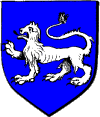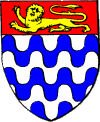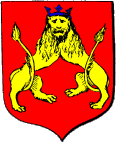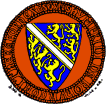Lion
Lion
Lion, (fr. lion): this beast is perhaps the most frequent of all bearings. In early heraldry it is generally represented rampant, while leopards are represented passant guardant, and hence the arms of England, not doubt, are more correctly blazoned, Leopards. Practically, however, the same animal was intended, but different names given according to the position; in later times the name lion was given to both. The chief evidence is that the first entry in one of out earliest rolls of arms runs:--
Le Roy d'Angleterre porte goules, trois lupards d'or--Roll, temp. HEN. III.
Son fitz teile, ovecque ung labell d'azur--Ibid.
And in the early roll of Edward II. the royal arms thus blazoned:--
Le Roy de Engletere porte de goules, iij lupars passauns de or.
And it will be observed that in the former it is taken for granted that the term 'lupar' involves passant.
Again, as a general rule more than two lions are seldom represented in the same shield, and, on the other hand, seldom less than two leopards. The commonest bearings are one lion or three leopards. The lions are drawn conventionally, and the design is suited to the material or character of the work into which they are introduced.


As already said, the position of rampant is the one most common, as it was thought to be the most natural for the lion. It signifies rearing, but with the sinister hinder leg and the sinister fore leg lower than the two dexter legs respectively. The lion is rarely represented rearing with both its hind legs touching the ground and its fore legs even; when it is so it is blazoned salient. A lion rampant, like all other animals, is always understood to be facing the dexter side of the shield.
Le Conte de Arundell de goules, ung lion rampand d'or--Roll, temp. HEN. III.
Le Conte DEL ILE, d'or, ung lion d'azur rampant--Roll, temp. HEN III.
Sire Roger FELBRIGGE, de or a, un lion salient de goules--Roll, temp. ED. II.
Or, six lions[or lioncels] salient sable--DATELING.
Azure, a lion salient or--Robert SNOWDEN, Bp. of Carlisle, 1616-21.
Argent, a lion salient gules--LIGHTON, Scotland.
Argent, a lion salient guardant gules--JERMY.
The head may be, however, turned to face the spectator, when it is said to be rampant guardant, or it may be turned completely round, when it is said to be rampant reguardant. Two lions rampant facing each other are blazoned combatant.

Argent, a lion rampant guardant or--FITZHAMON, Gloucester.
Argent, a lion rampant guardant gules--CATTESBY, Suffolk.
Azure, semy de lis a lion rampant guardant or--HOLLAND, Earl of Kent.
Or, a lion rampant reguardant sable--JENKINS, Cornwall.
Gules, a lion rampant reguardant argent--MORGAN, Bp. of Bangor, 1666-73.
Argent, a lion rampant reguardant gules--AGINAL, Cresseley.
Argent, a lion rampant gules facing the sinister side--VIVIAN, Cornwall.
Ermine, two lions rampant combatant gules--LUCAS, Cornwall.




The lion passant is more frequently represented guardant than not, but it ought rightly to be expressed: rarely is it represented passant reguardant. As already said, the term leopard was the ancient term used, and this in some cases evidently implied a lion passant guardant; so much so that with the French heralds the expression lion leopardé signifies a lion passant guardant, and conversely a leopard lionné a lion rampant guardant. When blazoned spotted the leopard itself is meant.
Azure, a lion passant argent--LYBAND; PALGRAVE &c.
Gules, two lions passant guardant in pale or--arms ascribed to WILLIAM I., WILLIAM II., and HENRY I. [But on no early authority.]
Sire Robert DE LA MARE, de goules, a ij lupars passanz de argent--Roll, temp. ED. II. [Engraving from arms in March Baldon Church, and blazoned Gules, two lions passant guardant in pale argent.]
Sire Johan GIFFARD, de goules, a iij lyouns passauns d'argent--Ibid.
Monsire de LITTLEBERY, d'argent, sur une bend vert trois egles d'or entre deux leopards gules passants--Roll, temp. ED. III.
Barry nebuly of six argent and azure; on a chief gules a lion passant guardant or--Company of STAPLE MERCHANTS[Inc. temp. ED. III.]
D'Azure, a deux lions leopardés or--PUISAYE, Normandie.
Gules, two leopards passant in pale argent spotted sable--MARE, Chester.
Lions may also be blazoned as couchant(fr. couché); they then should be represented with their heads erect, to distinguish term from dormant(of which no actual example occurs; though Guillim ascribes to the Tribe of Judah, 'Azure, a lion dormant or'). The term lodged is equivalent to couchant, but should only be applied to deer, &c., not to beasts of prey. The term statant(fr. posé) is also found occasionally applied to the lion, that is standing with both the fore legs touching the ground, and thus distinguished from passant, in which case the right gamb is raised. It may also be séjant.
Gules, a lion couchant between six cross crosslets, three in chief and as many in base argent--TYNTE, Somerset.
Gules, a lion couchant or--EILEWORTH.
Ermine, a lion statant guardant gules--Simon de SEGRE.
Per pale sable and gules, a lion statant argent--NEALE, co. Bedford.
Argent, a lion sejant sable--MEGGISON.
Lions are very frequently crowned; they are subject also to various treatments, sometimes being charged with some device on the shoulder, sometimes collared. A lion may also be represented as supporting some other charge, that is, holding it between its paws, but this is more frequently the case in crests than it coats of arms. Lions may also be of any tincture, and even party-coloured, in fact they are in this respect treated just as any ordinary.

Sire Johan de SEGRAVE, de sable, a un lioun rampant de argent courone de or--Roll, temp. ED. II. [The engraving is from arms in Dorchester Church, Oxon.]
Sire Johan de BEAUCHAMP de Fifelde, de or, a un lion de sable corone de goules--Ibid.
Gules, a lion passant guardant argent crowned with an antique crown or, and girt round the waist with an annulet of the last--OGILVIE.
Sire Nicholas de ESTLEE, de argent, a un lion de goules; en le espaudle del lion un quintefoil de argent--Roll, temp. ED. II.
Monsire Jerves de CLIFTON, port d'azure, a une lyon rampant d'argent en lespau une fleur-de-lys de gules--Roll, temp. ED. III.
Argent, three bars gemel sable, and over all a lion rampant gules charged on the shoulder with a crosslet fitchy or--Roger de MOHAUT, co. Lancaster.
Argent, a lion rampant vert vulned proper at the mouth--Tyrwhitt-JONES, co. Salop.
Gules, on a leopard passant guardant or spots sable--ARLOTT.
Argent, five barrulets gules, over all a lion rampant crowned and sustaining a battle-axe or--ALEXANDER.
Gules, a lion rampant holding in the dexter paw a pen argent--GREY.
Argent, a lion passant sable, the fore-feet fettered or--Madoc ap ADDA MOEL.
Or, a lion hopping in a tun gules[otherwise, Gules, a demi-lion erect issuing from a tun argent]--HOPTON[a Rebus].
Azure, a lion rampant vairy argent and gules--HULTON.
Gules, a lion passant ermine--HEREFORD, Norfolk,
Gules, a lion rampant, per bend ermine and ermines--TIMBERLEY.
Gules, a lion rampant guardant per fesse or and argent--Priory HOUNSLOW, Middlesex.
Sir Thomas de WOKINGDONE, de goules, a un lion barre de argent et de azure--Roll, temp. ED. II.
A lion may be armed, or armed and langued, of a different tincture(i.e. with its tongue, claws, or teeth, &c., of such tincture); or disarmed, that is deprived of claws and teeth; also enraged or incensed, that is with fire issuing from the mouth and ears,
Ermine, a lion rampant azure, crowned and langued or--PICKERING.
Ermine, a lion rampant gules, crowned or, armed and langued azure--TURBERVILLE, Bp. of Exeter, 1555-9.
Argent, three bars gemel gules, a lion rampant sable armed and membered azure--FAIRFAX.
Argent, a lion rampant gules enraged azure--ETHRICK.
Azure, a lion rampant argent, maned or, collared sable--LOKYER.
Azure, a lion rampant guardant argent the feet gules--HUM.
Argent, a lion passant disarmed sable--SMITH.
Argent, a lion unarmed gules--ALBONE.
Argent, a lion rampant gules incensed azure--Morgan ap MEREDITH, Lord of Tredegar, co. Monmouth.

But beyond this heralds frequently describe the tail of lion in the blazon; for instance, the animal may be represented as coward, that is, with its tail hanging down between the hind legs(whence the English word); it may also be represented with the tail erect, but this is rare, the ordinary position for the tail being as if curved over the back; it is very often forked(queue fourché), that is a double tail, and this is sometimes represented nowed or knotted. An illustration of fourché is seen in Woodford Church, Northants, on the brass of Symon MALORY, who died in 1580. Without a tail a lion is said to be defamed.

Argent, a lion passant coward sable--HERWELL.
Le Conte LEICESTER, goules ung leon rampand d'argent, le cowe fourchee--Roll, temp. HEN. III. [i.e. Simon DE MONTFORT, Earl of Leicester, temp. King JOHN. The annexed engraving represents a common form found in early drawing.]
Sire Adam de WELLES, de or, a un lion rampand de sable od la couwe forchee--Roll, temp. ED. II.
In the same Roll of Arms, Sire Johan de KYNESTONE; Sire Johan de KYNGESTONE; Sire Walter de KINGESTONE; Sire Nicolas de KINGESTONE; Sire William de CRESCI; Sire Roger de CRESCI; Sire Johan de HAVERINGE; Sire Bertilmeu de BOROVASH; Sire Johan de SEINCLER; Sire Robert le VENOUR; Sire Felip de WELLES; Sire Felip de BARINGTONE; Sire Roger de CHAUNDOS; Sire Robert de HASTANG; Sire Robert de STAPELTONE; Sire Edmon WASTENEYS; Sire ... de MORLEE; also bear lions 'rampaund, od la couwe fourchie.'
Sire Richard de BREOUSE, de ermyne a un lion rampaund de goules, od la couwe forchie e renouwe--Roll, temp. ED. II. [Sire Giles de BREOUSE and Sire Pere de BREOUSE bear lions similarly forked and nowed.]
Gules, a demi-lion rampant argent tail forked--STOKES.
Argent, two bars gules, over all a lion rampant, double queued or pelletty--BRANDON, Chamberlain of London.
Or, a lion rampant, tail forked gules--MALORY.
Argent, a lion rampant, tail forked and double nowed purpure--Sir William STOREY.
Purpure, a lion rampant, tail forked and nowed or, crowned argent--Sir Richard PASHLEY.
Argent, a lion rampant sable, the tail introverted, the head, paws, and brush of the tail of the field--LLOYD, co. Carmarthen.
Argent, a lion rampant, the tail elevated and turned over the head sable--BUXTON, Norfolk.
Argent, a lion rampant reguardant purpure, the tail flexed from between his legs over the back--Sir Amand de ROUCH.
Argent, a lion rampant, tail nowed purpure--STOREY.
Gules, a lion rampant, tail erect argent--Randolph de GERNONIIS, fourth Earl of Chester.


Lions also may be represented couped, when they are called demi-lions(q.v.), and there are besides this some singular combinations of two or several lions' bodies, but with only one head.
Gules, a bicorporate lion guardant rampant counter-rampant coward or, ducally crowned azure--John NORTHAMPTON, Lord Mayor of London, 1381 and 1382.
Gules, three demi-lions rampant argent--BENNETT.
Gules, two lions sejant conjoined under one head guardant or, crowned azure--COMBERTON.
Or, a lion rampant with two heads azure--Simon MASON, co. Huntingdon, 1730.
Gules, two lions rampant conjoined with one head or, crowned azure within a bordure argent--KELLHAM.
Gules, a tricorporated lion issuing out of the three corners of the escutcheon, all meeting under one head in the fesse point or, armed and langued azure--Edmond PLANTAGENET(Crouchback), Earl of Lancaster, temp. ED. I.
Argent, a lion guardant with two bodies counter rampant per pale gules and sable--Davy HOWELL. [The same charge, azure, in a field or, in the coat of NASHE.]


Lions' heads sometimes occur in blazon, but more frequently leopards' heads. A leopard's head should shew part of the neck, but the phrase is sometimes used for what should be termed a leopard's face. See Caboshed.
Monsire William de REDNESSE, sable une cheveron entre trois testes du leopard arrasht d'argent--Roll, temp. ED. III.
Monsire LUGHTBURGH, de gules a une cheveron d'argent entre trois testes de leopardes d'or--Ibid.
Azure, a leopard's head affronté erased or--MITCHELL.
Azure, three leopard's faces argent--BARNES, Linc., and BARNEY, Kent.
Azure, a fesse between three leopard's faces or--DE LA POLE, Earl of Suffolk.
Sable, a fesse between three leopard's faces argent--GIBBONS, Ireland.
Or, a fesse between three leopard's heads sable--FARINGDON, co. Lancaster.
Argent, a bend between two lion's heads erased sable--MELL[or MELLS.]
Azure, a fesse ermine between three lion's heads erased or--HAMMOND, Kent.
Azure, two bars argent, in chief a leopard's face or--WRIGHT, Cranham Hall, Essex.
Argent, a fesse humetty gules, in chief three leopard's faces of the second--BRABANT.
Argent, a fesse dancetty gules, in chief three leopard's heads cabossed azure--John de POULTNEY.
Sable, in chief a lion passant guardant, in base a leopard's head jessant-de-lis or--MORLAND.
See also examples under jessant-de-lis. Lions' gambes(q.v.) and paws are also often borne as separate charges, as likewise, but rarely, the tail.

Lioncels, (fr. lionceaux). When two or more lions occur in the same coat not separated by an ordinary, they are more properly blazoned(except in a royal coat, or except in the case of two lions combatant or addorsed) as lioncels, the dignity of a lion being supposed not to allow a competitor in the same field. Practically, however, in modern blazon the term lioncel is only used when there are five or six. The arms of LONGESPEE, Earl of Sarum(natural son of Henry II.), and of Humphrey de BOHUN, Earl of Hereford, are found very frequently in old glass, &c., and present good examples of lioncels. The first engraving here given is from the seal attached to the will of Humphrey de Bohun(the son), who died 1319.


Le Conte de HEREFORD, azure six lionceux d'or ov ung bende d'argent a deux cotises d'or--Roll, temp. HENRY III.
Humphry de BOUN, d'azur ung bend d'argent entre six leonceux d'or cotisee d'or, ove ung labell de goules--Ibid.
Le Counte de HEREFORD, de azure, a vi lioncels de or a une bende de argent e ij cottes de or--Roll, temp. ED. II.
Azure, six lioncels rampant three, two, one, or--William LONGESPEE, Earl of Sarum, ob. 1226. [The arms are varied from those of ANJOU, the ancient inheritance of his father's family, which were azure, eight lioncels(or perhaps lioncels sans nombre) or.]
Sire Edmon TALEBOT, de argent a iij lioncels de pourpre--Roll, temp. ED. II.
Sable, six lioncels couchant coward argent three, two, and one--BATEMEN, Essex.
Argent, on a bend engrailed between six lioncels gules, a rose of the first between two arrows proper--SAWREY, co. Lancaster.
Argent, on a cross gules five lioncels rampant or--AUDYN, Dorchester.
Please Help!
DrawShield is a Free service supported by its users.

If you can, please help cover the cost of the server, or just buy the team a coffee to say thanks!
 Buy me a coffee
Buy me a coffee


